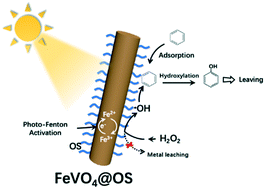Photocatalytic hydroxylation of benzene to phenol over organosilane-functionalized FeVO4 nanorods†
Abstract
Photocatalytic benzene hydroxylation reaction using a clean oxidant such as H2O2 is a green synthetic approach for phenol synthesis. Here, our study shows that silylated iron vanadate (FeVO4) nanorods can function as promising photocatalysts to direct hydroxylation of benzene to phenol, by taking advantage of the unique benefits of covalently bonded organosilane (OS) groups to realize kinetic control of heterogeneous photocatalytic reactions. The grafting of OS functional groups on FeVO4 helps to tailor its surface affinity to fine-tune the benzene adsorption behavior and photo-Fenton process for H2O2 activation. In addition, the OS groups immobilized on the FeVO4 surface via a rather strong Si–O bond also serve as an effective protective coating to suppress metal leaching, thus affording FeVO4 with an excellent stability to undergo a heterogeneous photo-Fenton process. As a result, the silylated FeVO4 exhibits robust photocatalytic benzene hydroxylation performance. The phenol yield and selectivity obtained on the optimized silylated FeVO4 are determined to be 20% and 98%, much better than that obtained from pristine FeVO4. Benefiting from its robust stability and tunable surface affinity, the silylated FeVO4 will have broad applications in photocatalytic selective oxidation to produce fine chemicals.



 Please wait while we load your content...
Please wait while we load your content...